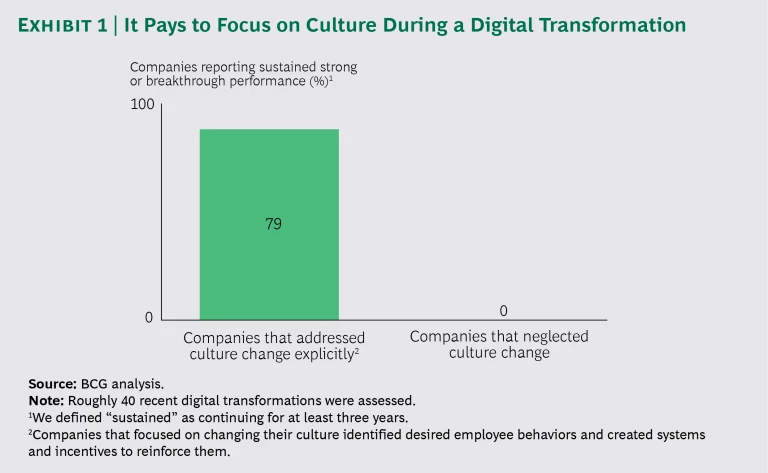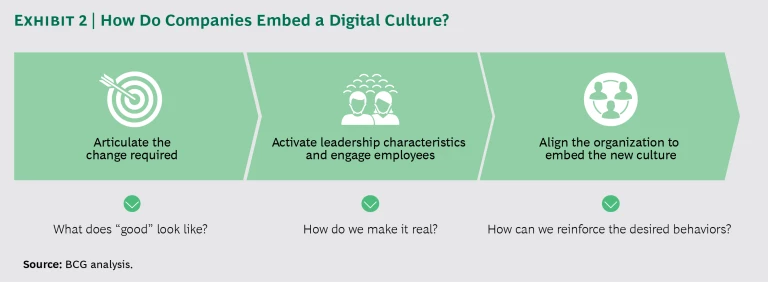Digital transformation is sweeping the business landscape. Leaders are embracing it wholeheartedly because they recognize its power. But as companies advance from pilot programs to wide-scale adoption, they often run into an unexpected obstacle: culture clash.
Being a digital organization means not only having digital products, services, and customer interactions but also powering core operations with technology. Becoming one, therefore, requires a tectonic change in the activities employees perform as well as in their individual behaviors and the ways they interact with others inside and outside the organization. Although it should come as no surprise that the traditional ways of working are incompatible with the new ways, it often does.
Leaders need to acknowledge digital transformation as the fundamental, strategic paradigm shift that it is. Like any major transformation, a digital transformation requires instilling a culture that supports the change while enabling the company’s overarching strategy.
Embedding a digital culture in an organization is doable, but it takes a clear methodology and a disciplined effort. Before we describe the critical moves companies must make to build an enduring digital culture, let’s first examine the reasons that having a digital culture is so important.
Why Instilling a Digital Culture Matters
Culture comprises the values and characteristic set of behaviors that define how things get done in an organization. A healthy culture provides the guidelines—the tacit code of conduct—that steer individuals to act appropriately and make choices that advance the organization’s goals and strategy. We see three important reasons for instilling a digital culture during a digital transformation.
By ignoring culture, an organization risks transformation failure. We assessed roughly 40 digital transformations and found that the proportion of companies reporting breakthrough or strong financial performance was five times greater (90%) among those that focused on culture than it was among those that neglected culture (17%).
Nearly 80% of the companies that focused on culture sustained strong performance.
The case for fostering a digital culture is even more powerful if we look at sustained performance: nearly 80% of the companies that focused on culture sustained strong or breakthrough performance. Not one of the companies that neglected to focus on culture achieved such performance. (See Exhibit 1.)
A digital culture empowers people to deliver results faster. Digital organizations move faster than traditional ones, and their flatter hierarchy helps speed decision making. A digital culture serves as a code of conduct that gives employees the latitude to make judgment calls and on-the-spot decisions.
For many digital organizations, this code of conduct amounts to a singular focus on the customer. Consider the example of a North American software provider. Aware that its new software-as-a-service product would require a much faster response to customers’ needs than its existing product demands, leaders communicated five essential new behaviors that they expected of employees. Among those behaviors: making decisions on their own and challenging the status quo in order to make decisions that are favorable to customers.
A digital culture attracts talent. Having a reputation as a digital leader is a magnet for talent. Millennials are generally drawn to digital companies, with their promise of a collaborative, creative environment and greater autonomy. It’s no wonder that websites such as LinkedIn.com and Glassdoor.com are increasingly used by job seekers to get insiders’ perspectives on a company’s culture.
Having a digital culture is particularly important in attracting digital talent, the demand for which is rapidly outpacing the supply. Large, established companies must often employ new methods for attracting, developing, and retaining the talent needed to support their digital transformation. (See How to Gain and Develop Digital Talent and Skills , the New New Way of Working Series, BCG Focus, July 2017.) Leading banks are a good example of those that are changing their approach.
Since the 2008 global financial crisis, graduates from the world’s top ten MBA schools are 40% less likely to accept a job in investment banking than they were before the crisis.
The Five Core Elements of a Digital Culture
A healthy digital culture is a type of high-performance culture. To understand the essential elements of a digital culture, it helps to be aware of the three critical attributes of a high-performance culture.
First, employees and teams are engaged to achieve results: they are committed to their work and to the organization’s purpose and goals, and they are willing to go the extra mile. Second, individuals and teams work in ways that will advance the organization’s strategy. Third, the organizational environment, or “context”—including leadership, organization design, performance management, people-development practices, resources and tools, vision and values, and informal interactions—is set up to foster engagement and encourage behaviors that will advance the organization’s strategy. (See High-Performance Culture , BCG Focus, June 2013.)
Just as there is no universal strategy, there is no standard digital culture. Still, a digital culture typically has five defining elements:
- It promotes an external, rather than an internal, orientation. A digital culture encourages employees to look outward and engage with customers and partners to create new solutions. A prime example of external orientation is the focus on the customer journey; employees shape product development and improve the customer experience by putting themselves in the customer’s shoes.
- It prizes delegation over control. A digital culture diffuses decision making deep into the organization. Instead of receiving explicit instructions on how to perform their work, employees follow guiding principles so that their judgment can be trusted.
- It encourages boldness over caution. In a digital culture, people are encouraged to take risks, fail fast, and learn, and they are discouraged from preserving the status quo out of habit or caution.
- It emphasizes more action and less planning. In the fast-changing digital world, planning and decision making must shift from having a long-term focus to having a short-term one. A digital culture supports the need for speed and promotes continuous iteration rather than perfecting a product or idea before launching it.
- It values collaboration more than individual effort. Success in a digital culture comes through collective work and information sharing across divisions, units, and functions. The iterative and fast pace of digital work requires a far greater level of transparency and interaction than that found in the traditional organization.
These defining elements vary in degree from industry to industry and from company to company. The degree of risk-taking that’s appropriate at a technology firm will not be the same as the degree that is appropriate at an industrial goods company, for example. And even within an organization, the desired levels of risk-taking will vary; the strategy team, for example, should embrace risk to a much greater degree than the finance team. Encouraging risk-taking is intended to foster thinking outside the box without being reckless or breaching regulation or company policy.
Articulate, Activate, and Align: Three Steps to a Digital Culture
How do companies shift to their desired digital culture? How can they avoid the missteps that have tripped up so many companies thus far? We’ve identified three crucial actions. (See Exhibit 2.)
Articulate the change required. When companies clearly define the behaviors that matter and their employees adhere to them, organizations can realize a strong culture and are more likely to reap results. (See the sidebar.) Yet leaders often stumble in this effort.
THE CULTURE-PERFORMANCE PAYOFF
We analyzed culture diagnostic data from 75 publicly traded companies, determining where each company fell along the spectrum for each of several cultural dimensions—including structured or flexible, controlling or delegating, and cautious or risk-permitting. For example, for each company, we ascertained whether its culture was strongly structured, strongly flexible, or somewhere in between. We then aggregated the results for each company and classified its culture as weak, mixed, or strong.
We also analyzed these companies’ total shareholder return (TSR). We found that the five-year TSR of companies with a strong culture was twice the five-year TSR of the S&P 1200—and more than twice the five-year TSR of companies with a weak culture. (See the exhibit.)
The performance payoff is also evident over the long term: companies with a strong culture had a ten-year TSR roughly twice that of the S&P 1200.
Leaders must first identify the characteristics of their target digital culture on the basis of the company’s strategy, goals, and purpose. The language they choose should be unambiguous, especially because increasingly, employee interactions with customers and coworkers are no longer face to face. Leaders then need to translate each cultural characteristic into specific behavior examples. This step should be followed by an assessment of the current culture, whether by survey, interview, focus group, or some combination thereof. Finally, leaders must identify the gap between current and target behaviors—and integrate the required changes into the communications related to the cultural change.
To clarify the characteristics of a digital culture, leaders should look to the tech industry. For example, the Manifesto for Agile Software Development is the proclamation of agile values and behaviors that launched the agile movement, and some companies use it to foster a digital culture. Companies can also consult digital players. Executives at a European financial institution took field trips to leading tech companies. Inspired by the practices they witnessed, the executives were better able to identify the behaviors they needed at their company. Their list (which included sample dos and don’ts), along with an assessment of current and target behaviors, helped them create a new “culture code.” Workshops and action plans helped instill the new behaviors in employees.
Leaders should look to the tech industry to clarify the characteristics of a digital culture.
Activate leadership characteristics and engage employees. All high-performing cultures—especially digital ones—require strong leadership and engaged employees. In digital cultures, teams need to act autonomously, for example, and people must exercise judgment. But words alone aren’t enough to spur such behaviors. Leaders—whether they are in the C-suite or on the frontlines—must embrace and manifest these behaviors.
Companies can activate leadership characteristics by creating everyday opportunities for leaders to serve as role models of the new behaviors; for example, they can introduce new routines and rhythms to daily work to reflect desired behaviors. A North American financial institution that was undergoing a digital transformation made it a practice to rotate meeting leaders, which empowered a wider variety of people in meetings. Companies should encourage leaders to coach their team members daily to practice the new behaviors in real time.
Companies must incentivize the right behaviors to successfully embed a new culture.
Signaling change with symbolic acts that embody the new culture is a good way to activate leadership characteristics quickly. For example, companies can designate meeting-free days to emphasize greater focus on action over planning, or they can give engineers a cash allowance to buy their own desktop equipment to demonstrate trust. Sometimes even a bold move, such as firing people whose behavior is antithetical to the new culture, is warranted. To signal change at Cisco, executives in certain divisions gave up their offices so the company could create team rooms; the company also started allowing employees to choose the workspace and tech tools that best fit their individual roles. The CEO of the North American software provider cited earlier began sending notes to employees who are praised by name in customer reviews. Such acknowledgment serves as an example of how company leaders can reinforce the customer-first mindset that’s central to the company culture.
Activating leadership characteristics is essential for spurring employee engagement, which is particularly important in a digital culture, given its emphasis on autonomy, judgment, customer focus, and an entrepreneurial mindset. Leaders should engage employees through nontraditional means. Novartis, for example, uses gamification to teach employees about its products as well as to emphasize company values.
Align the organizational context to embed the new culture. Because a digital transformation represents a departure from the way a traditional business operates, companies typically test it using a pilot program run by the very best leaders. To elicit new behaviors from these executives, companies modify executives’ performance review criteria as well their areas of accountability. Companies also change these executives’ decision rights to accelerate decision making. When the pilot succeeds, these top leaders are ready to roll out the transformation.
The trouble is that the changes that helped and incentivized the executives to make the pilot a success do not exist in the broader organization; neither managers nor employees are prepared or motivated to adopt the new ways of working.
Scaling a digital culture is a challenge. A traditional culture, based on hierarchical power and teams or units competing for resources, is in many ways antithetical to a digital culture, with its emphasis on delegation, collaboration, and speed. But unless companies change the organizational context—the underlying systems, processes, and practices—it’s virtually impossible to extend and embed the new behaviors throughout the organization. Embedding becomes not only the most challenging part but also the most time consuming. It’s no wonder that many transformations stop short and eventually falter.
To successfully embed a new culture, companies need to anticipate what they need to do beyond running the pilot. They need to revisit their operating model. They also need to stimulate new practices by reviewing each one of the organizational context areas—leadership, organization design, performance management, people-development practices, resources and tools, vision and values, and informal interactions—and making specific changes that incentivize the right behaviors and discourage the undesirable ones. Changes should also be made to companies’ screening and hiring policies and practices to seek out prospects who exhibit the new behaviors.
Companies can embed a new culture in a number of ways. For example, among other moves, L’Oréal hired a chief digital officer to lead a team that provides digital expertise to the company’s business units, while also advancing companywide digital priorities. Adobe Systems abolished its annual performance management reviews, replacing them with real-time “feed forward” sessions that focus on upcoming goals. And British Gas adopted Yammer as a corporate social collaboration platform; it allows people to share praise and best practices and work together across functions.
Leaders at a life sciences company reviewed their company’s “DNA statement”—a commitment to passion, quality, integrity, engagement, and innovation—to ensure that the principles and the company’s systems supported the new digital culture. To reinforce passion, the leaders created a job rotation program and allowed employees to work on a digital project of their choosing. Leaders promoted quality and integrity through a digital expert network and digital modules in the company’s onboarding and training programs. To bolster engagement, leaders held an annual digital summit and introduced a collaboration award for teams that devised bold new ideas. They also promoted innovation by upgrading equipment and redecorating the work environment to make it more futuristic and inspiring.
As with any transformation, leaders who guide a digital transformation are often preoccupied with structural and process changes and overlook the people side—only to wonder why the effort faltered. It’s well established that cultural change is a key determinant of a successful transformation. For digital transformations, that truth applies to the nth degree. The behaviors that embody a digital culture represent a major shift from longstanding norms—and particularly challenge traditional power structures, decision-making authority, and fundamental views of competition and cooperation among employees.
The window of opportunity is narrowing. It won’t be long before being a fully digital organization will be table stakes. By shaping and embedding a digital culture now, companies can secure competitive advantage while investing in their long-term, sustainable performance.














